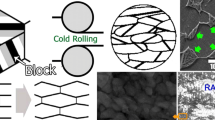Conclusions
-
1.
The cavitation resistance of unstable austenitic steels is highest with the optimal rate of the martensite transformation under the influence of microimpacts.
-
2.
By alloying and preliminary plastic deformation it is possible to change the rate of the martensite transformation to the optimal and increase the cavitation resistance of unstable austenitic steels.
Similar content being viewed by others
Literature cited
I. N. Bogachev and R. I. Mints, Cavitation Damage of Iron — Carbon Alloys [in Russian], Mashgiz, Moscow (1959).
I. N. Bogachev and R. I. Mints, Increasing the Cavitation — Erosion Resistance of Machine Parts [in Russian], Mashinostroenie, Moscow (1964).
L. S. Ershova et al., Fiz. Metal. Metalloved., ul12, No. 5 (1961).
Additional information
Urals' Polytechnical Institute. Translated from Metallovedenie i Termicheskaya Obrabotka Metallov, No. 12, pp. 50–52, December, 1971.
Rights and permissions
About this article
Cite this article
Malinov, L.S., Éismondt, T.D. & Bogachev, I.N. Effect of the kinetics of the martensitic transformation on the cavitation resistance of unstable austenitic steels. Met Sci Heat Treat 13, 1044–1046 (1971). https://doi.org/10.1007/BF00665004
Issue Date:
DOI: https://doi.org/10.1007/BF00665004




